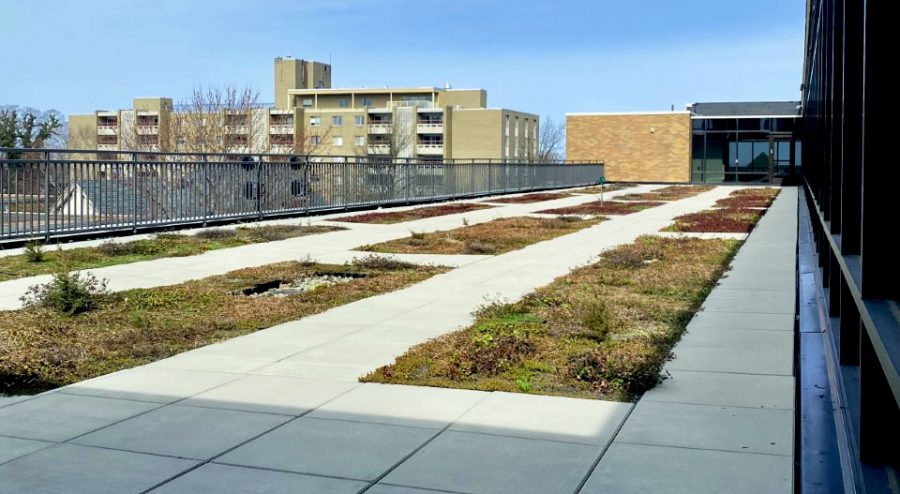Gannon continues sustainability efforts, joins Erie 2030 District
The Nash Library green roof was part of the renovations on the building that started in 2016. The roof was added to enhance the sustainability of the building’s design and provides Gannon’s biology and environmental science students with hands-on experience.
March 30, 2021
Green roofs. Recycling initiatives. New solar-powered buildings. These are just a few environmentally friendly strategies employed across Gannon University’s campus.
These strategies are set to become more prevalent with Gannon’s new pledge to the Erie 2030 District and the Green Building Alliance.
Gannon recently made a pledge to the Erie 2030 District to reduce energy, water, and emissions produced by 50% by 2030, from a 2003 baseline. According to Mark Kennelley, assistant director of Gannon’s physical plant, this pledge creates a partnership between Gannon, the Erie 2030 District and the Green Building Alliance.
The Green Building Alliance is the regional chapter of the U.S. Green Building Council for the western part of Pennsylvania, serving Greater Pittsburgh, the Laurel Highlands and Northwest Pennsylvania.
Erie 2030, according to Michelle Homan, a professor in the environmental science and engineering program at Gannon, was created to incentivize a high-performing building district in Erie, similar to what has been done in other cities across the U.S., including Pittsburgh.
The initiative, she said, involves a group of agencies, institutions and businesses in Erie that have committed to reducing the energy, water and emissions by 50% from a start date of 2003. Gannon is the 16th property partner to join the district.
“Forming a collaborative in a given city helps in many ways, as it increases the purchasing power, increases incentives, transfers knowledge and experiences from one business to another and provides technical assistance,” Homan said.
The pledge requires that each property partner track energy usage and strive toward a reduction in energy use, which is ideally 50%. In creating its own pledge, Gannon is now striving to meet that reduction in the next nine years.
“As part of the alliance, we have to track our current energy usage, basically our utility costs,” Kennelley said. “To strive toward that 50% reduction in energy use, water consumption, electric costs and natural gas costs, there are some initiatives that we are putting forth.”
One example of a possible initiative is adding solar-powered waste compactors, which will compact the trash being thrown away, Kennelley said.
The Erie 2030 District also helps property partners with their energy efficiency initiatives. They offer energy efficiency workshops that provide market trends, relevant energy and water efficiency programs and other networking opportunities with community members involved.
The initiative with Erie 2030 also provides many student opportunities, said Homan. Students will be able to collect data, conduct energy audits and recommend solutions for reducing energy and water usage.
“This is a valuable skill in the workplace, as businesses and organizations are looking to save money on building energy costs,” she said.
According to Kennelley, a student worker position will also be implemented. The student worker will help with data analytics of energy costs to see where the university is and what needs to be done to reach the 50% reduction by 2030.
Once that data is compiled, the Green Building Alliance will provide Gannon with research and advice that can assist the university in reaching the 50% mark within the next decade, Kennelley said.
As the pledge was just recently made, Kennelley said that not much is known about it, and they don’t have all of the information they need from the Green Building Alliance.
There are many benefits to Gannon’s pledge with the Erie 2030 District and Green Building Alliance, Homan said.
These include reduced long-term energy costs, reduced carbon footprint, increased environmental awareness in the Gannon community, educational opportunities from students, local and national public relations opportunities and incentive programs as part of the Erie 2030 District Collaborative.
Since a 2003 baseline is used for reductions in energy use, some progress has already been made toward reducing energy emissions.
“Gannon has already made a considerable effort since this time in reducing its energy usage across campus,” Homan said. “There are further strategies that can be implemented in order to reach this goal.”
These strategies can have a direct impact on climate change. According to Homan, there is a direct connection between using less energy and decreasing greenhouse gas emissions, which in turn reduces climate change implications. By adopting and implementing sustainability strategies, institutions can set a tone around environmental awareness.
“This can increase the likelihood that others will adopt these strategies,” Homan said. “This could include a range of changes, from turning the lights off in a classroom after class to increasing the likelihood that the institution might look at a green energy supplier for their electricity company or adopting energy conservation strategies at home.”
To see the impact of institutions adopting environmental sustainability strategies, Homan said to look at Pittsburgh as a model. With a well-established and effective 2030 District itself, building owners have reduced their energy usage and associated energy costs.
In addition, the awareness and importance of energy conservation and its role in climate change has increased in the Pittsburgh community.
“The same will hopefully occur with Erie as district members transfer their knowledge and experience with other building owners and community members in the area,” Homan said.
“This creates momentum for reducing energy usage and addressing the issue of climate change.”
MADELINE BRUCE






